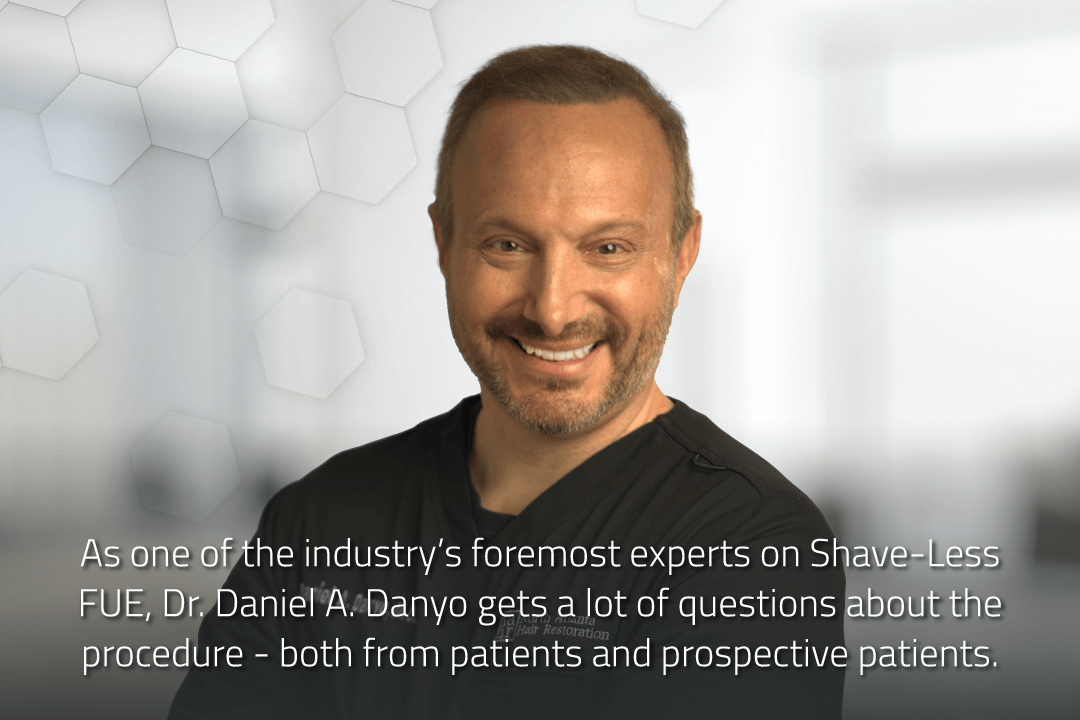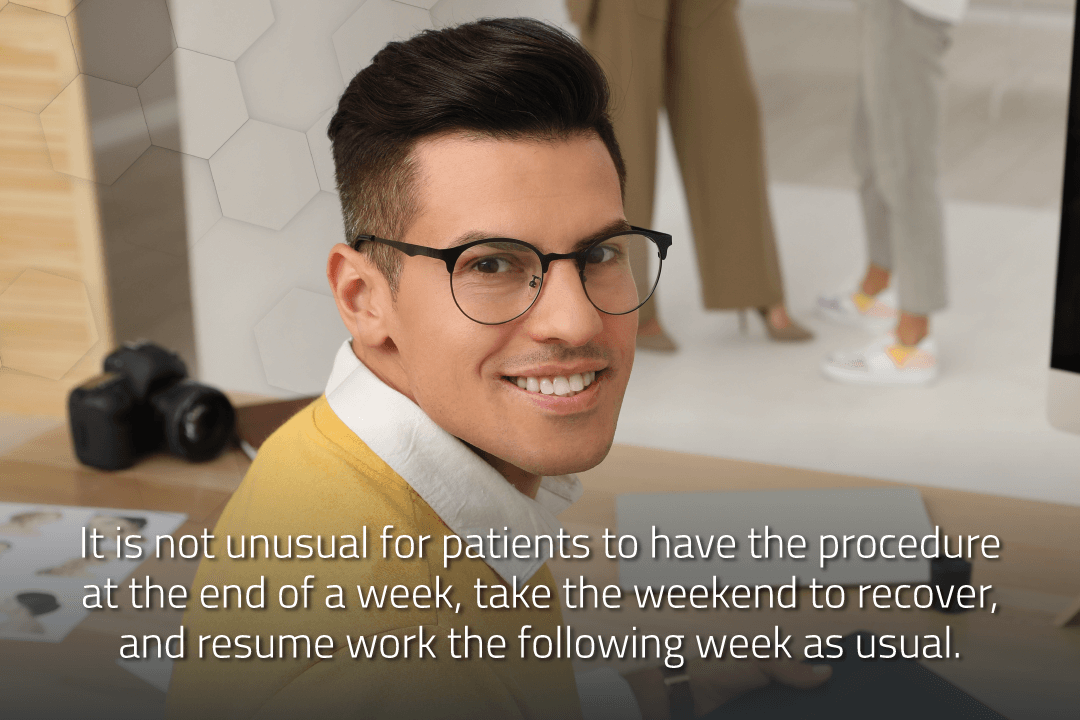Answers to Commonly Asked Questions About Shave-Less FUE (No-Shave FUE)
As one of the industry’s foremost experts on Shave-Less FUE, Dr. Daniel A. Danyo gets a lot of questions about the procedure—both from patients and prospective patients. Here are answers to a few of the most common questions Dr. Danyo hears in his practice.
What is Shave-Less FUE?
Shave-Less FUE is a hair restoration procedure where healthy hair follicles are harvested from an area of thicker growth, and re-implanted in thinning areas. The procedure does not require shaving the patient’s head or removing a strip of scalp.
What is the difference between Shave-Less FUE and traditional FUE?
“FUE” stands for “Follicular Unit Excision.” Both of these procedures—Shave-Less and traditional FUE—are follicular unit excision procedures, in which healthy hair follicles are harvested from one area of the scalp and re-implanted in another.
The difference is that with traditional FUE, the patient’s head is shaved. In actuality, only a portion of the patient’s head needs to be shaved, but the entire head is usually shaved for cosmetic reasons.
With Shave-Less FUE, there is no need for the patient’s head to be shaved. Our patients tend to prefer it because it is one of the most discreet types of hair restoration procedures available today.
What is the difference between No-Shave FUE and FUT?
“FUT” stands for “Follicular Unit Transplant.” This is an older type of hair restoration procedure in which a strip of the patient’s scalp is removed, and healthy hair follicles are harvested from that strip.
This procedure is still sometimes performed today. However, it leaves a telltale linear scar, and the recovery period can be long and painful compared with other available procedures such as traditional and Shave-Less FUE.
Does Shave-Less FUE hurt?
The procedure takes place under local anesthesia. The vast majority of our patients report little or no discomfort during the procedure, and some even find it relaxing. A few even fall asleep!
In addition to his experience as a leading hair restoration surgeon, Dr. Danyo has a background in pain management. He is highly experienced in making sure every patient is as comfortable as possible.

How long will it take to recover after Shave-Less FUE?
Most of our patients take a few days to resume normal activities after a Shave-Less FUE procedure. It is not unusual for patients to have the procedure at the end of a week, take the weekend to recover, and resume work the following week as usual.
Will anyone be able to tell I’ve had a No-Shave FUE procedure?
Shave-Less FUE is one of the most discreet types of hair restoration surgery available. Many of our patients report that the people in their lives—even their own families—don’t notice any signs of the procedure, even just days afterward.
How long will it take to see results after a Shave-Less FUE procedure?
Every patient is different. However, here is a fairly typical timeframe for hair regrowth after you’ve undergone a Shave-Less FUE procedure.
First week: You may see some redness and irritation on the affected areas of your scalp. This usually heals quickly.
One to three weeks: You should see the initial redness and irritation subside by now, and you can resume your normal showering and shampooing routine.
One to three months: You may notice hairs falling out during this time. This is a normal part of the process—your hair follicles are reviving after briefly going dormant, and are pushing old hair growth out so they can start anew.
Three to six months: Here’s where you’ll see the start of your new hair growth. It may be thinner, finer and lighter than usual, or it may grow in uneven. This is also normal, as your follicles will heal at different rates.
Six to nine months: Many FUE patients report continuing slow or patchy regrowth during this period, and the rate of regrowth can vary widely depending on the skill of the surgeon and the technique used.
At our clinic, most of our patients see about 60% to 80% of their new hair growth around this time, although some patients may experience slower growth and recovery.
Nine to twelve months: Most people see about 90% of their new hair growth by now.
Twelve to 18 months: While many patients see the bulk of their regrowth by now, it’s not unusual for some hair follicles to continue to heal at this point. It can take as long as 18 months to see the full results of your hair restoration procedure.
In addition, the color and texture of your hair may vary slightly as your follicles continue to adjust.
Can women get Shave-Less FUE?
Both women and men can be candidates for Shave-Less FUE. However, this procedure is more commonly recommended for men, due to the different ways hair loss presents in men and women.
Like other forms of FUE and FUT, Shave-Less FUE requires a portion of the scalp to have thick, healthy hair growth to harvest follicles from. Hair loss in women tends to be more diffuse than it is in men, so women are less likely to have an area of stable growth to harvest from.
However, there are some types of hair loss in women that are compatible with Shave-Less FUE. Feel free to get in touch if you’d like Dr. Danyo to assess your hair loss and let you know whether you are a good candidate for the procedure.
How many No-Shave FUE procedures will I need?
It depends on many factors including your level of hair loss, your existing state of health, and your goals for restoration surgery.
Some of our patients to return for several procedures. This is not because the first procedure didn’t work—you will inevitably see new growth in areas with graft transplants—but because they have experienced hair loss in other areas that they wish to remedy, or they’d like to get even thicker and fuller results.

Am I a good candidate for Shave-Less FUE?
It depends on many factors, including your age and general state of health, your pattern of hair loss, and whether or not you have a suitable donor site to harvest healthy hair follicles from.
To have Dr. Danyo evaluate your hair loss personally and make a recommendation, get in touch here. The consultation is free and confidential.
What is the post-operative recovery period like?
Post-operative recovery is the shortest and least painful with Shave-Less FUE of any surgical hair transplant procedure.
You may experience some mild discomfort during the recovery period, and notice irritation and redness on your scalp. This usually fades within a week to ten days, and most of our patients are back to work and normal activity within a few days of their procedure.
Your surgeon will give you detailed directions for steps to take in the days just after your procedure to hasten recovery.
Got more questions about Shave-Less FUE? Ask Dr. Danyo
Get in touch now to schedule a free, confidential virtual consultation with Dr. Danyo. Dr. Danyo will evaluate your hair loss and make a tailored recommendation. Get started now.

